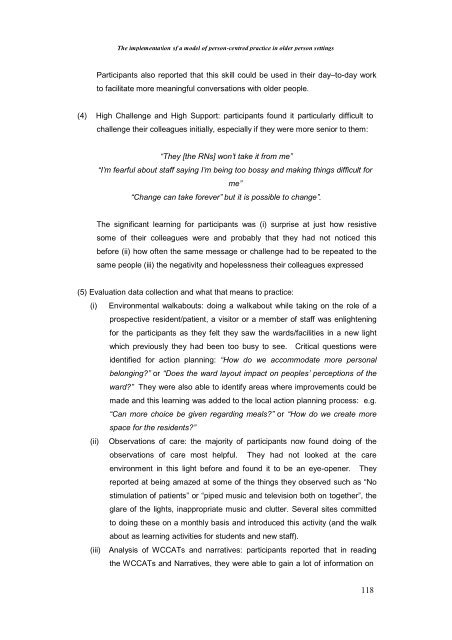The Implementation of a Model of Person-Centred Practice In Older ...
The Implementation of a Model of Person-Centred Practice In Older ...
The Implementation of a Model of Person-Centred Practice In Older ...
You also want an ePaper? Increase the reach of your titles
YUMPU automatically turns print PDFs into web optimized ePapers that Google loves.
<strong>The</strong> implementation <strong>of</strong> a model <strong>of</strong> person-centred practice in older person settings<br />
Participants also reported that this skill could be used in their day–to-day work<br />
to facilitate more meaningful conversations with older people.<br />
(4) High Challenge and High Support: participants found it particularly difficult to<br />
challenge their colleagues initially, especially if they were more senior to them:<br />
“<strong>The</strong>y [the RNs] won’t take it from me”<br />
“I’m fearful about staff saying I’m being too bossy and making things difficult for<br />
me”<br />
“Change can take forever” but it is possible to change”.<br />
<strong>The</strong> significant learning for participants was (i) surprise at just how resistive<br />
some <strong>of</strong> their colleagues were and probably that they had not noticed this<br />
before (ii) how <strong>of</strong>ten the same message or challenge had to be repeated to the<br />
same people (iii) the negativity and hopelessness their colleagues expressed<br />
(5) Evaluation data collection and what that means to practice:<br />
(i) Environmental walkabouts: doing a walkabout while taking on the role <strong>of</strong> a<br />
prospective resident/patient, a visitor or a member <strong>of</strong> staff was enlightening<br />
for the participants as they felt they saw the wards/facilities in a new light<br />
which previously they had been too busy to see. Critical questions were<br />
identified for action planning: “How do we accommodate more personal<br />
belonging?” or “Does the ward layout impact on peoples’ perceptions <strong>of</strong> the<br />
ward?” <strong>The</strong>y were also able to identify areas where improvements could be<br />
made and this learning was added to the local action planning process: e.g.<br />
“Can more choice be given regarding meals?” or “How do we create more<br />
space for the residents?”<br />
(ii) Observations <strong>of</strong> care: the majority <strong>of</strong> participants now found doing <strong>of</strong> the<br />
observations <strong>of</strong> care most helpful. <strong>The</strong>y had not looked at the care<br />
environment in this light before and found it to be an eye-opener. <strong>The</strong>y<br />
reported at being amazed at some <strong>of</strong> the things they observed such as “No<br />
stimulation <strong>of</strong> patients” or “piped music and television both on together”, the<br />
glare <strong>of</strong> the lights, inappropriate music and clutter. Several sites committed<br />
to doing these on a monthly basis and introduced this activity (and the walk<br />
about as learning activities for students and new staff).<br />
(iii) Analysis <strong>of</strong> WCCATs and narratives: participants reported that in reading<br />
the WCCATs and Narratives, they were able to gain a lot <strong>of</strong> information on<br />
118
















